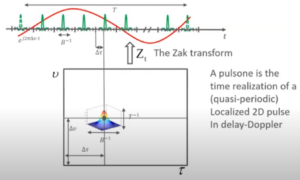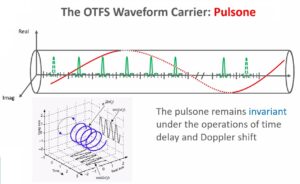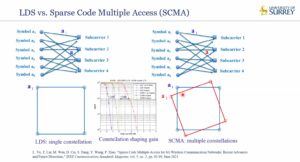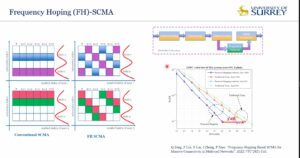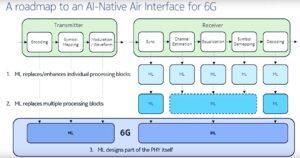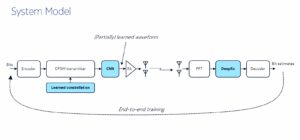At the May 2022 6G Symposium, three speakers proposed modulation and coding methods for 6G. As you might expect, they keep getting more complex to handle the expected higher data rates.
FM, QPSK, QAM, CDMA, TDMA, GSM, OFDM. These are some of the modulation and coding schemes used in cellular technologies over the years. Each generation — except 5G, which uses ODFM as does LTE — has brought another modulation technique because of the need for higher data rates. 6G will likely require yet new techniques for modulation and coding. As for which techniques, we still don’t know.
At the May 2022 6G Symposium, three engineers gave presentations on possible technologies for 6G radios. One thing seems certain: machine learning (ML) will play a more significant role in 6G than it does in 5G.
Figure 1. A Pulsone is a combination of a pulse and tone, related through the Zak Transform. Source: Cohere Technologies
Ronny Hadani of Cohere Technologies proposed orthogonal time-frequency space (OTFS), which he described as a combination of Radar and communications signals. OTFS creates a delay-Doppler radar image of a transmitter’s surroundings, by which software can predict what’s coming next as a transmitter moves. Combined with machine learning, the delay-Doppler technique can, according to Cohere, be used to predict how a transmitted signal will behave in the face of reflections and other impediments. As Hadani’s paper describes, “all received QAM symbols experience the same localized impairment, and all the delay-Doppler diversity branches are coherently combined.”
The OTFS signal is “the fusion of a tone and a pulse” related through the Zak Transform (Figure 1). Hadani used the term “Pulseone” (pronounced pulSONE) to describe the OTFS waveform carrier. A Pulsone (Figure 2) holds its shape when shifted in time or in frequency (Doppler shift). “When you apply a FFT to a Pulsone, you get a Pulsone.” Thus, a Pulsone is invariant to distortion and delay from Doppler shift.
Hadani’s paper (linked above) explains OFTS in detail. You can also watch Hadani give a detailed lecture here.
Figure 3. An SCMA waveform uses two or three constellations, That provides redundancy but adds complexity. Source: University of Surrey
Prof. Pei Xiao of the University of Surrey, a leading wireless research university, proposed a completely different concept that he called Sparse Code Multiple Access (SCMA). Xiao’s concept is based on using multiple subcarriers per user, where a user’s data is interleaved on two or three subcarriers. The result is two or three constellations (Figure 3). The difference is, said Xiao, 1.5 dB compared to OFDMA, which lacks the ability to use more than one constellation.
The problem with those constellations, according to Xiao, is that the signal processing is too complex to be practical. You end up with 3D modulation. Xiao proposed several techniques for simplifying the signal-processing algorithms.
Figure 4. Frequency hopping is one of several techniques for reducing SCMA signal complexity. Source: University of Surrey
One such technique, called an Expectation Propagation, a Bayesian inference algorithm, that reduces overall complexity because the complexity increases linearly with additional constellations as opposed to increasing exponentially.
Xiao also pointed to frequency hopping as another way to reduce complexity (Figure 4).
Adding frequency hopping between the SCMA encoding and OFDM modulation. Frequency hopping reduces the chances that some codes will be lost due to fading because data is spread across several frequencies.
Figure 5. This roadmap to a 6G waveform heavily depends of machine learning. Source: Nokia Bell Labs
Thus, if one frequency shows fading, another might reach the receiver, ensuring successful decoding.
Dani Korpi of Nokia Bell Labs discussed neither a specific modulation nor coding. Instead, he suggested that machine learning could be used to “learn” a waveform based on the full air interface, fram transmitter to receiver. Korpi discussed the roadmap in Figure 5 where ML replaces not only processing blocks, but the transmitter physical layer and constellation.
Figure 6. ML could be used to learn the waveforms for both the transmitter and receiver. Source: Nokia Bell Labs
“Let neural networks learn the design” doesn’t mean that ML can generate a complete design, for it would need a basic design to learn and then improve upon. From that information, Figure 6 shows how ML could then optimize the receiver as well.
The video below covers the entire session on 6G waveforms.

